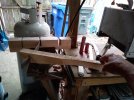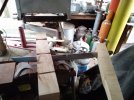- Joined
- Aug 13, 2022
- Messages
- 134
Just got all of my15 blades of diff shapes back from the heat treater ..all went well with the exception if 1 blade has a small warp (to be honest I expected much more) my question is this fixable?
The warp is behind the plunge line not affecting the blade (the part I want heat-treated) I was thinking I could keep the blade wet Rag etc. then block up the tip of the blade and the butt end Warp facing up. And heat a small band or area behind the plunge line (middle of the warp) with my torch and bring it back to straight with a c -clamp and my straight edge.
Do you think this might work or do You's fellas throw them away at this point????
Thanks Jerry
The warp is behind the plunge line not affecting the blade (the part I want heat-treated) I was thinking I could keep the blade wet Rag etc. then block up the tip of the blade and the butt end Warp facing up. And heat a small band or area behind the plunge line (middle of the warp) with my torch and bring it back to straight with a c -clamp and my straight edge.
Do you think this might work or do You's fellas throw them away at this point????
Thanks Jerry



